University Report: Brand Management of ASDA Supermarket
VerifiedAdded on 2021/01/02
|25
|5557
|57
Report
AI Summary
This report provides a detailed analysis of ASDA's brand management strategies. It begins with an introduction to brand management and its significance, followed by an examination of key constituents of a positive brand strategy, including brand loyalty, awareness, and equity. The report then delves into how brands are managed over time, applying Keller's Brand Equity Model to assess ASDA's brand identity, meaning, response, and relationships with customers. The analysis continues with a discussion of brand portfolio management, brand hierarchies, and equity management, including strategies like umbrella branding and endorsed brand strategies. Furthermore, the report evaluates techniques for leveraging and extending brands both domestically and internationally, followed by an assessment of techniques used in the measurement and management of brand value. The report uses examples within the ASDA organizational context and concludes with a critical evaluation of branding within the organization, highlighting marketing's role in building brand positioning and equity.
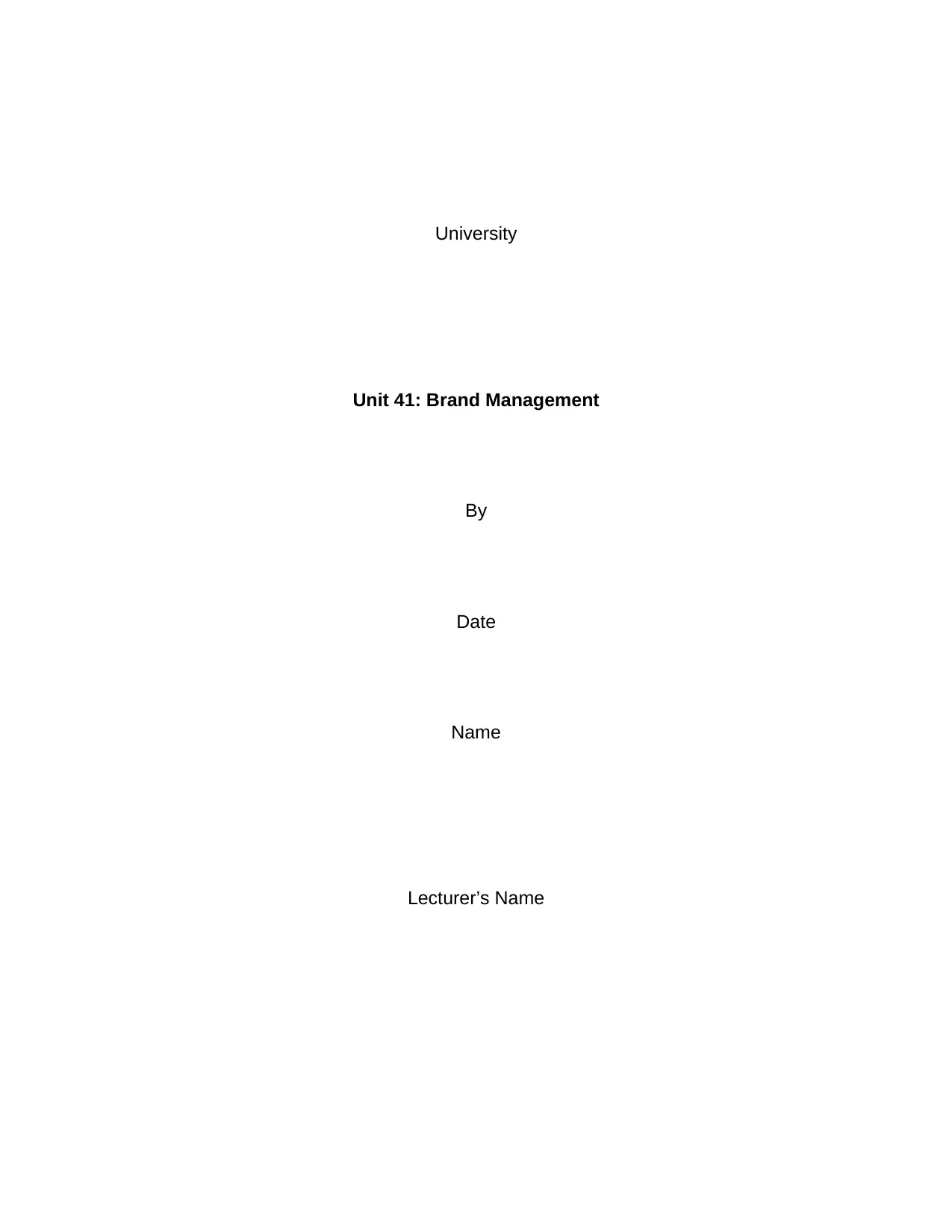
University
Unit 41: Brand Management
By
Date
Name
Lecturer’s Name
Unit 41: Brand Management
By
Date
Name
Lecturer’s Name
Paraphrase This Document
Need a fresh take? Get an instant paraphrase of this document with our AI Paraphraser
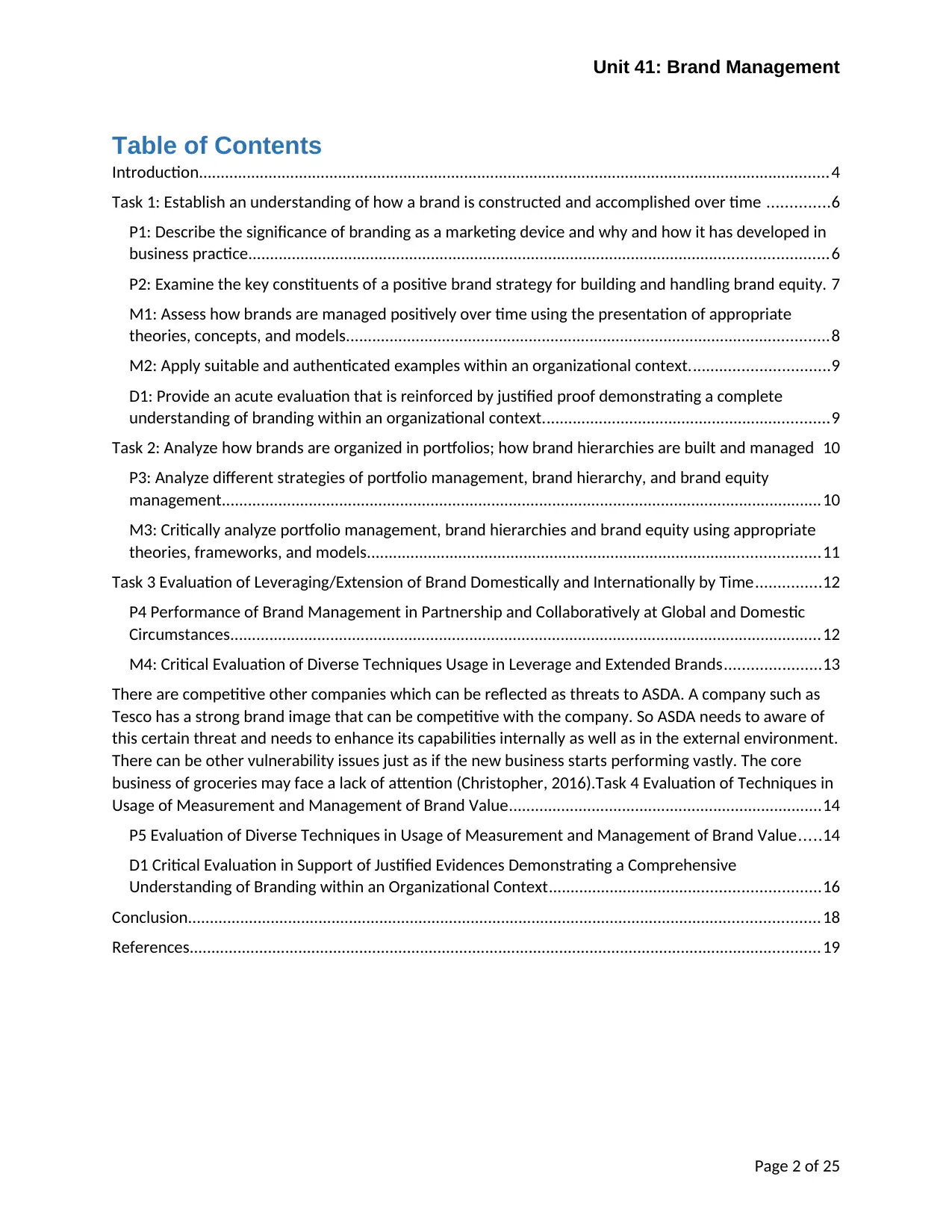
Unit 41: Brand Management
Table of Contents
Introduction.................................................................................................................................................4
Task 1: Establish an understanding of how a brand is constructed and accomplished over time ..............6
P1: Describe the significance of branding as a marketing device and why and how it has developed in
business practice.....................................................................................................................................6
P2: Examine the key constituents of a positive brand strategy for building and handling brand equity. 7
M1: Assess how brands are managed positively over time using the presentation of appropriate
theories, concepts, and models...............................................................................................................8
M2: Apply suitable and authenticated examples within an organizational context................................9
D1: Provide an acute evaluation that is reinforced by justified proof demonstrating a complete
understanding of branding within an organizational context..................................................................9
Task 2: Analyze how brands are organized in portfolios; how brand hierarchies are built and managed 10
P3: Analyze different strategies of portfolio management, brand hierarchy, and brand equity
management..........................................................................................................................................10
M3: Critically analyze portfolio management, brand hierarchies and brand equity using appropriate
theories, frameworks, and models........................................................................................................11
Task 3 Evaluation of Leveraging/Extension of Brand Domestically and Internationally by Time...............12
P4 Performance of Brand Management in Partnership and Collaboratively at Global and Domestic
Circumstances........................................................................................................................................12
M4: Critical Evaluation of Diverse Techniques Usage in Leverage and Extended Brands......................13
There are competitive other companies which can be reflected as threats to ASDA. A company such as
Tesco has a strong brand image that can be competitive with the company. So ASDA needs to aware of
this certain threat and needs to enhance its capabilities internally as well as in the external environment.
There can be other vulnerability issues just as if the new business starts performing vastly. The core
business of groceries may face a lack of attention (Christopher, 2016).Task 4 Evaluation of Techniques in
Usage of Measurement and Management of Brand Value........................................................................14
P5 Evaluation of Diverse Techniques in Usage of Measurement and Management of Brand Value.....14
D1 Critical Evaluation in Support of Justified Evidences Demonstrating a Comprehensive
Understanding of Branding within an Organizational Context..............................................................16
Conclusion.................................................................................................................................................18
References.................................................................................................................................................19
Page 2 of 25
Table of Contents
Introduction.................................................................................................................................................4
Task 1: Establish an understanding of how a brand is constructed and accomplished over time ..............6
P1: Describe the significance of branding as a marketing device and why and how it has developed in
business practice.....................................................................................................................................6
P2: Examine the key constituents of a positive brand strategy for building and handling brand equity. 7
M1: Assess how brands are managed positively over time using the presentation of appropriate
theories, concepts, and models...............................................................................................................8
M2: Apply suitable and authenticated examples within an organizational context................................9
D1: Provide an acute evaluation that is reinforced by justified proof demonstrating a complete
understanding of branding within an organizational context..................................................................9
Task 2: Analyze how brands are organized in portfolios; how brand hierarchies are built and managed 10
P3: Analyze different strategies of portfolio management, brand hierarchy, and brand equity
management..........................................................................................................................................10
M3: Critically analyze portfolio management, brand hierarchies and brand equity using appropriate
theories, frameworks, and models........................................................................................................11
Task 3 Evaluation of Leveraging/Extension of Brand Domestically and Internationally by Time...............12
P4 Performance of Brand Management in Partnership and Collaboratively at Global and Domestic
Circumstances........................................................................................................................................12
M4: Critical Evaluation of Diverse Techniques Usage in Leverage and Extended Brands......................13
There are competitive other companies which can be reflected as threats to ASDA. A company such as
Tesco has a strong brand image that can be competitive with the company. So ASDA needs to aware of
this certain threat and needs to enhance its capabilities internally as well as in the external environment.
There can be other vulnerability issues just as if the new business starts performing vastly. The core
business of groceries may face a lack of attention (Christopher, 2016).Task 4 Evaluation of Techniques in
Usage of Measurement and Management of Brand Value........................................................................14
P5 Evaluation of Diverse Techniques in Usage of Measurement and Management of Brand Value.....14
D1 Critical Evaluation in Support of Justified Evidences Demonstrating a Comprehensive
Understanding of Branding within an Organizational Context..............................................................16
Conclusion.................................................................................................................................................18
References.................................................................................................................................................19
Page 2 of 25
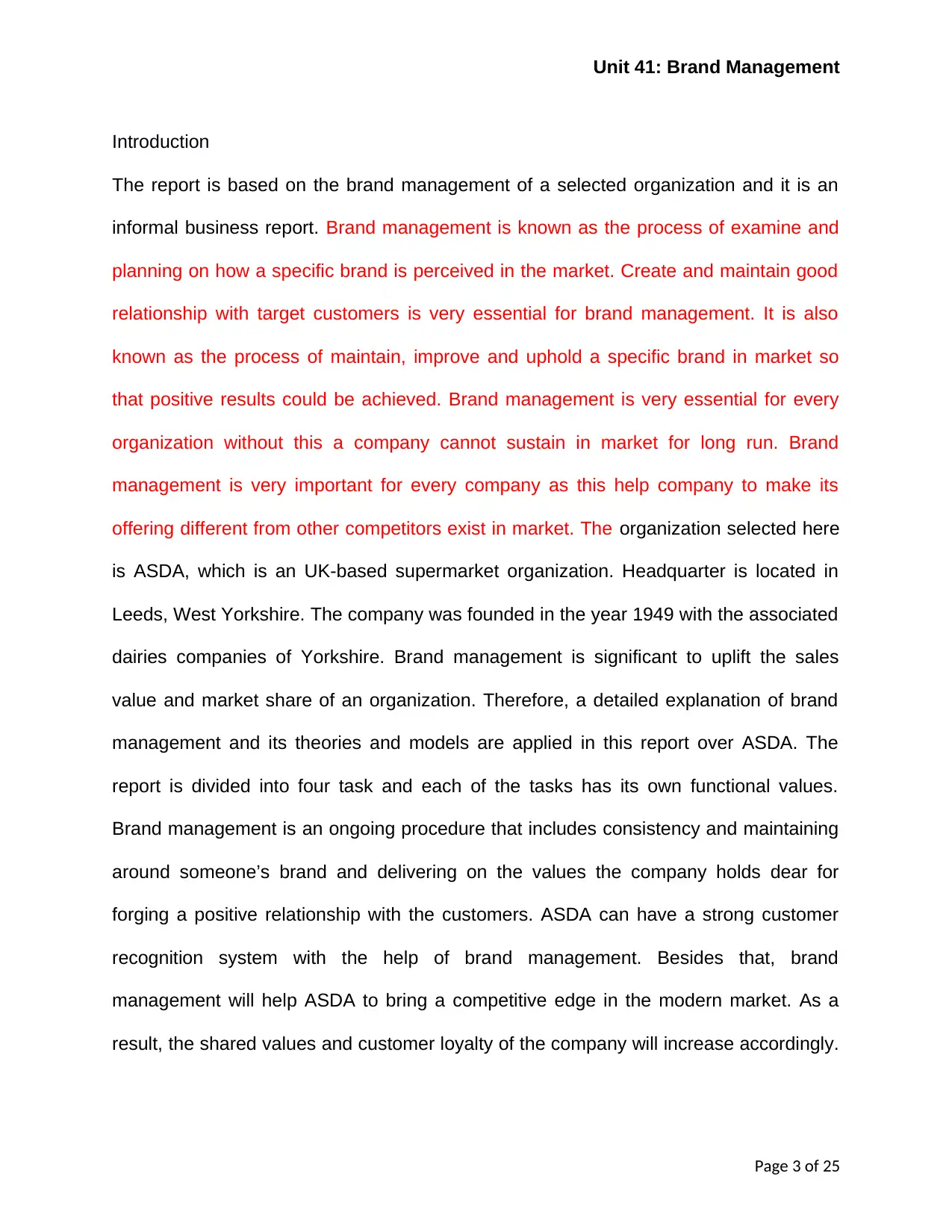
Unit 41: Brand Management
Introduction
The report is based on the brand management of a selected organization and it is an
informal business report. Brand management is known as the process of examine and
planning on how a specific brand is perceived in the market. Create and maintain good
relationship with target customers is very essential for brand management. It is also
known as the process of maintain, improve and uphold a specific brand in market so
that positive results could be achieved. Brand management is very essential for every
organization without this a company cannot sustain in market for long run. Brand
management is very important for every company as this help company to make its
offering different from other competitors exist in market. The organization selected here
is ASDA, which is an UK-based supermarket organization. Headquarter is located in
Leeds, West Yorkshire. The company was founded in the year 1949 with the associated
dairies companies of Yorkshire. Brand management is significant to uplift the sales
value and market share of an organization. Therefore, a detailed explanation of brand
management and its theories and models are applied in this report over ASDA. The
report is divided into four task and each of the tasks has its own functional values.
Brand management is an ongoing procedure that includes consistency and maintaining
around someone’s brand and delivering on the values the company holds dear for
forging a positive relationship with the customers. ASDA can have a strong customer
recognition system with the help of brand management. Besides that, brand
management will help ASDA to bring a competitive edge in the modern market. As a
result, the shared values and customer loyalty of the company will increase accordingly.
Page 3 of 25
Introduction
The report is based on the brand management of a selected organization and it is an
informal business report. Brand management is known as the process of examine and
planning on how a specific brand is perceived in the market. Create and maintain good
relationship with target customers is very essential for brand management. It is also
known as the process of maintain, improve and uphold a specific brand in market so
that positive results could be achieved. Brand management is very essential for every
organization without this a company cannot sustain in market for long run. Brand
management is very important for every company as this help company to make its
offering different from other competitors exist in market. The organization selected here
is ASDA, which is an UK-based supermarket organization. Headquarter is located in
Leeds, West Yorkshire. The company was founded in the year 1949 with the associated
dairies companies of Yorkshire. Brand management is significant to uplift the sales
value and market share of an organization. Therefore, a detailed explanation of brand
management and its theories and models are applied in this report over ASDA. The
report is divided into four task and each of the tasks has its own functional values.
Brand management is an ongoing procedure that includes consistency and maintaining
around someone’s brand and delivering on the values the company holds dear for
forging a positive relationship with the customers. ASDA can have a strong customer
recognition system with the help of brand management. Besides that, brand
management will help ASDA to bring a competitive edge in the modern market. As a
result, the shared values and customer loyalty of the company will increase accordingly.
Page 3 of 25
⊘ This is a preview!⊘
Do you want full access?
Subscribe today to unlock all pages.

Trusted by 1+ million students worldwide
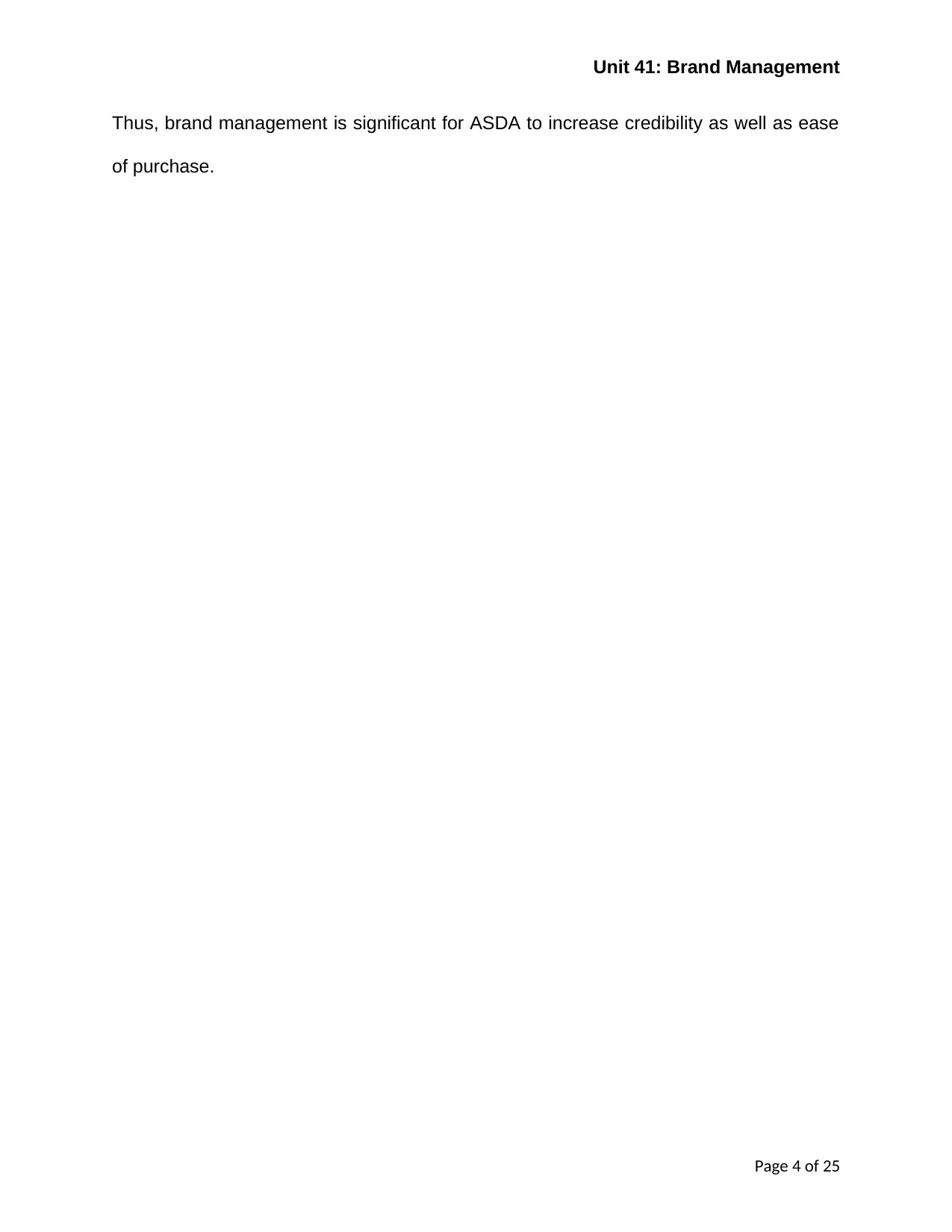
Unit 41: Brand Management
Thus, brand management is significant for ASDA to increase credibility as well as ease
of purchase.
Page 4 of 25
Thus, brand management is significant for ASDA to increase credibility as well as ease
of purchase.
Page 4 of 25
Paraphrase This Document
Need a fresh take? Get an instant paraphrase of this document with our AI Paraphraser
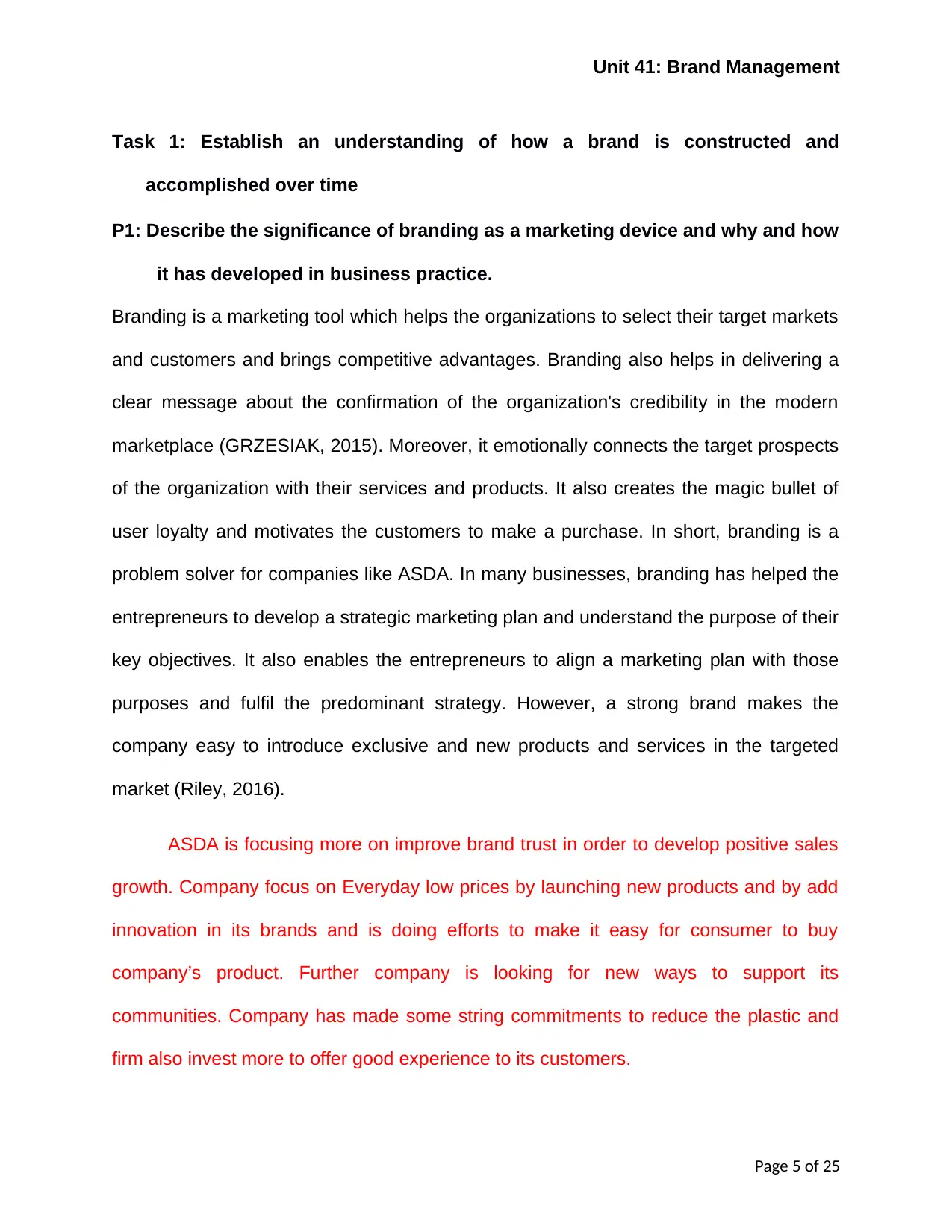
Unit 41: Brand Management
Task 1: Establish an understanding of how a brand is constructed and
accomplished over time
P1: Describe the significance of branding as a marketing device and why and how
it has developed in business practice.
Branding is a marketing tool which helps the organizations to select their target markets
and customers and brings competitive advantages. Branding also helps in delivering a
clear message about the confirmation of the organization's credibility in the modern
marketplace (GRZESIAK, 2015). Moreover, it emotionally connects the target prospects
of the organization with their services and products. It also creates the magic bullet of
user loyalty and motivates the customers to make a purchase. In short, branding is a
problem solver for companies like ASDA. In many businesses, branding has helped the
entrepreneurs to develop a strategic marketing plan and understand the purpose of their
key objectives. It also enables the entrepreneurs to align a marketing plan with those
purposes and fulfil the predominant strategy. However, a strong brand makes the
company easy to introduce exclusive and new products and services in the targeted
market (Riley, 2016).
ASDA is focusing more on improve brand trust in order to develop positive sales
growth. Company focus on Everyday low prices by launching new products and by add
innovation in its brands and is doing efforts to make it easy for consumer to buy
company’s product. Further company is looking for new ways to support its
communities. Company has made some string commitments to reduce the plastic and
firm also invest more to offer good experience to its customers.
Page 5 of 25
Task 1: Establish an understanding of how a brand is constructed and
accomplished over time
P1: Describe the significance of branding as a marketing device and why and how
it has developed in business practice.
Branding is a marketing tool which helps the organizations to select their target markets
and customers and brings competitive advantages. Branding also helps in delivering a
clear message about the confirmation of the organization's credibility in the modern
marketplace (GRZESIAK, 2015). Moreover, it emotionally connects the target prospects
of the organization with their services and products. It also creates the magic bullet of
user loyalty and motivates the customers to make a purchase. In short, branding is a
problem solver for companies like ASDA. In many businesses, branding has helped the
entrepreneurs to develop a strategic marketing plan and understand the purpose of their
key objectives. It also enables the entrepreneurs to align a marketing plan with those
purposes and fulfil the predominant strategy. However, a strong brand makes the
company easy to introduce exclusive and new products and services in the targeted
market (Riley, 2016).
ASDA is focusing more on improve brand trust in order to develop positive sales
growth. Company focus on Everyday low prices by launching new products and by add
innovation in its brands and is doing efforts to make it easy for consumer to buy
company’s product. Further company is looking for new ways to support its
communities. Company has made some string commitments to reduce the plastic and
firm also invest more to offer good experience to its customers.
Page 5 of 25
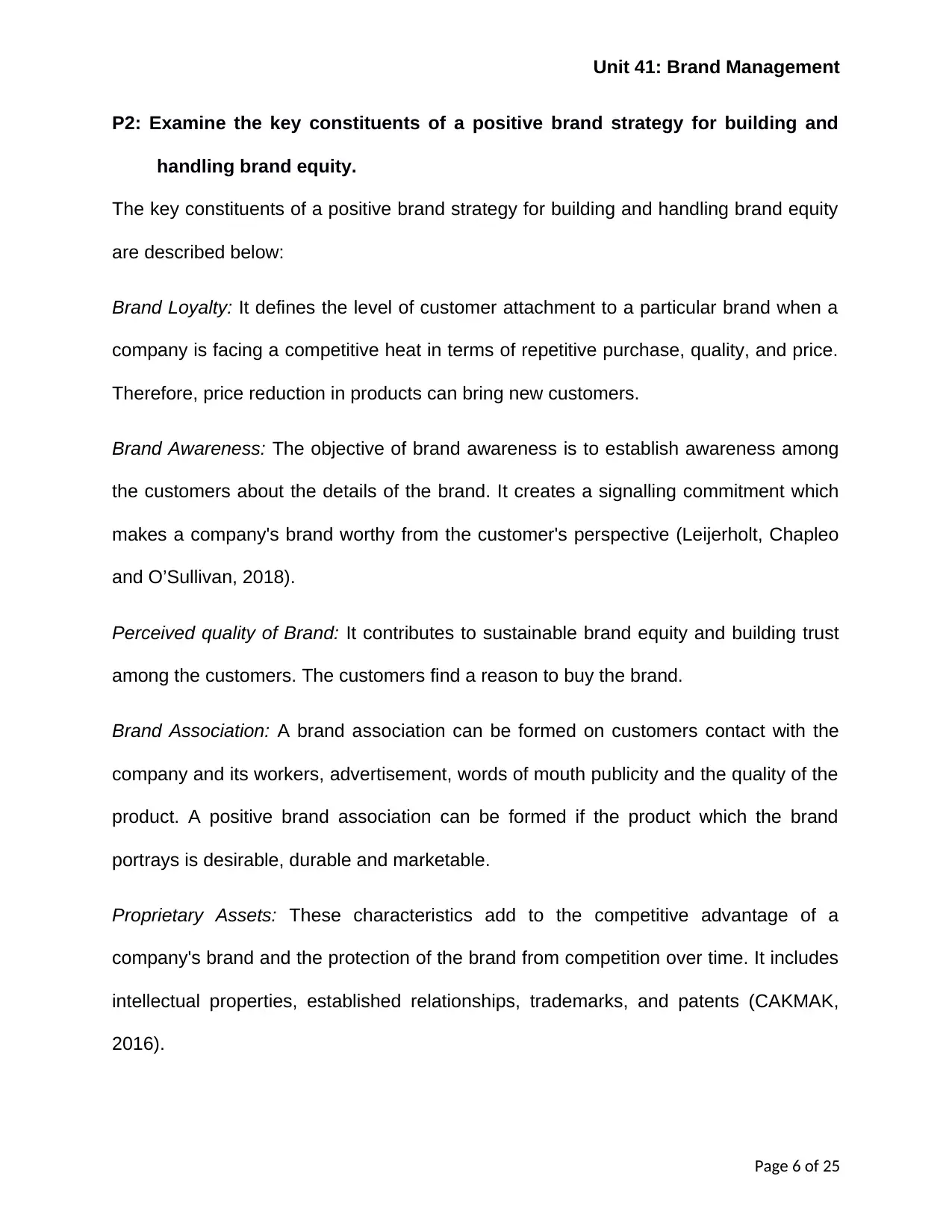
Unit 41: Brand Management
P2: Examine the key constituents of a positive brand strategy for building and
handling brand equity.
The key constituents of a positive brand strategy for building and handling brand equity
are described below:
Brand Loyalty: It defines the level of customer attachment to a particular brand when a
company is facing a competitive heat in terms of repetitive purchase, quality, and price.
Therefore, price reduction in products can bring new customers.
Brand Awareness: The objective of brand awareness is to establish awareness among
the customers about the details of the brand. It creates a signalling commitment which
makes a company's brand worthy from the customer's perspective (Leijerholt, Chapleo
and O’Sullivan, 2018).
Perceived quality of Brand: It contributes to sustainable brand equity and building trust
among the customers. The customers find a reason to buy the brand.
Brand Association: A brand association can be formed on customers contact with the
company and its workers, advertisement, words of mouth publicity and the quality of the
product. A positive brand association can be formed if the product which the brand
portrays is desirable, durable and marketable.
Proprietary Assets: These characteristics add to the competitive advantage of a
company's brand and the protection of the brand from competition over time. It includes
intellectual properties, established relationships, trademarks, and patents (CAKMAK,
2016).
Page 6 of 25
P2: Examine the key constituents of a positive brand strategy for building and
handling brand equity.
The key constituents of a positive brand strategy for building and handling brand equity
are described below:
Brand Loyalty: It defines the level of customer attachment to a particular brand when a
company is facing a competitive heat in terms of repetitive purchase, quality, and price.
Therefore, price reduction in products can bring new customers.
Brand Awareness: The objective of brand awareness is to establish awareness among
the customers about the details of the brand. It creates a signalling commitment which
makes a company's brand worthy from the customer's perspective (Leijerholt, Chapleo
and O’Sullivan, 2018).
Perceived quality of Brand: It contributes to sustainable brand equity and building trust
among the customers. The customers find a reason to buy the brand.
Brand Association: A brand association can be formed on customers contact with the
company and its workers, advertisement, words of mouth publicity and the quality of the
product. A positive brand association can be formed if the product which the brand
portrays is desirable, durable and marketable.
Proprietary Assets: These characteristics add to the competitive advantage of a
company's brand and the protection of the brand from competition over time. It includes
intellectual properties, established relationships, trademarks, and patents (CAKMAK,
2016).
Page 6 of 25
⊘ This is a preview!⊘
Do you want full access?
Subscribe today to unlock all pages.

Trusted by 1+ million students worldwide
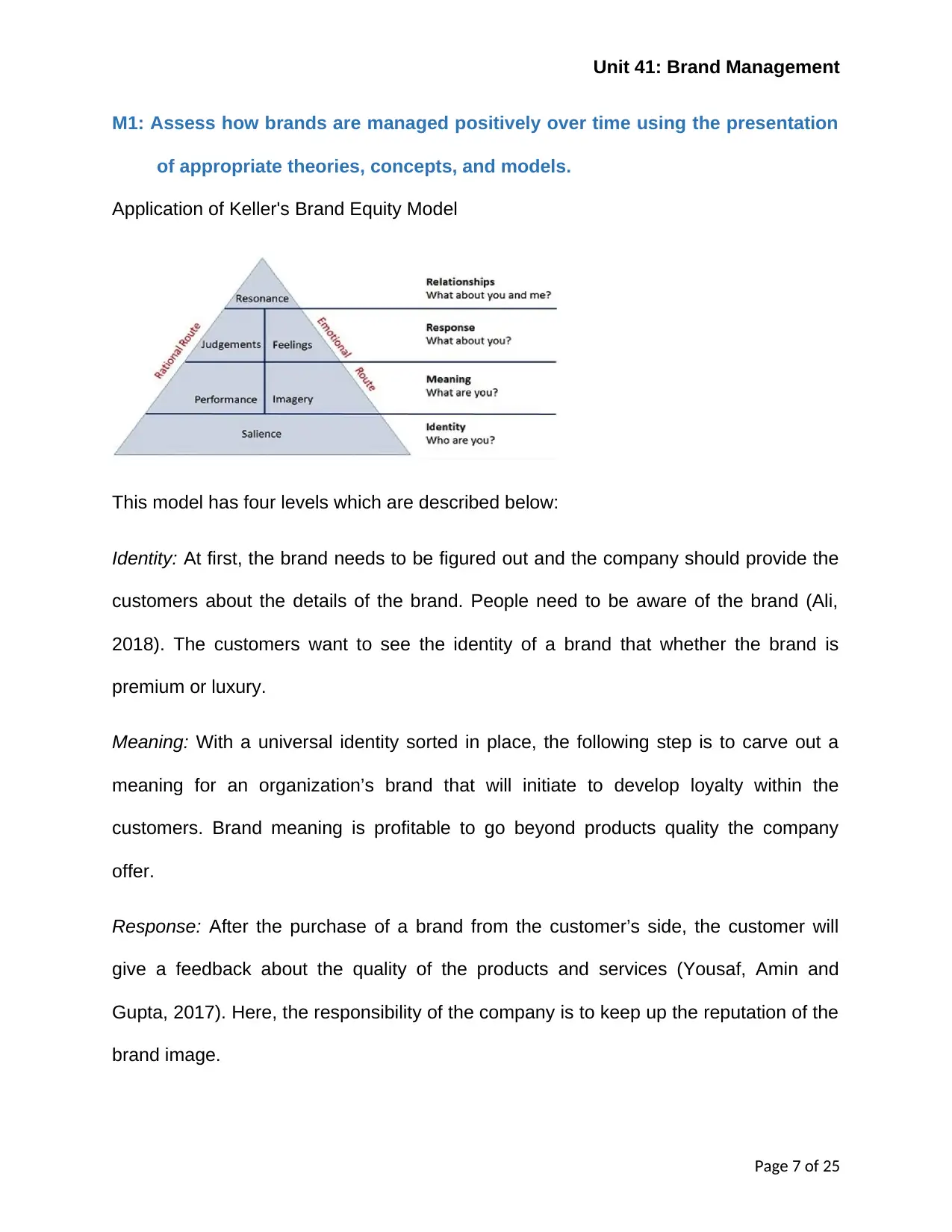
Unit 41: Brand Management
M1: Assess how brands are managed positively over time using the presentation
of appropriate theories, concepts, and models.
Application of Keller's Brand Equity Model
This model has four levels which are described below:
Identity: At first, the brand needs to be figured out and the company should provide the
customers about the details of the brand. People need to be aware of the brand (Ali,
2018). The customers want to see the identity of a brand that whether the brand is
premium or luxury.
Meaning: With a universal identity sorted in place, the following step is to carve out a
meaning for an organization’s brand that will initiate to develop loyalty within the
customers. Brand meaning is profitable to go beyond products quality the company
offer.
Response: After the purchase of a brand from the customer’s side, the customer will
give a feedback about the quality of the products and services (Yousaf, Amin and
Gupta, 2017). Here, the responsibility of the company is to keep up the reputation of the
brand image.
Page 7 of 25
M1: Assess how brands are managed positively over time using the presentation
of appropriate theories, concepts, and models.
Application of Keller's Brand Equity Model
This model has four levels which are described below:
Identity: At first, the brand needs to be figured out and the company should provide the
customers about the details of the brand. People need to be aware of the brand (Ali,
2018). The customers want to see the identity of a brand that whether the brand is
premium or luxury.
Meaning: With a universal identity sorted in place, the following step is to carve out a
meaning for an organization’s brand that will initiate to develop loyalty within the
customers. Brand meaning is profitable to go beyond products quality the company
offer.
Response: After the purchase of a brand from the customer’s side, the customer will
give a feedback about the quality of the products and services (Yousaf, Amin and
Gupta, 2017). Here, the responsibility of the company is to keep up the reputation of the
brand image.
Page 7 of 25
Paraphrase This Document
Need a fresh take? Get an instant paraphrase of this document with our AI Paraphraser
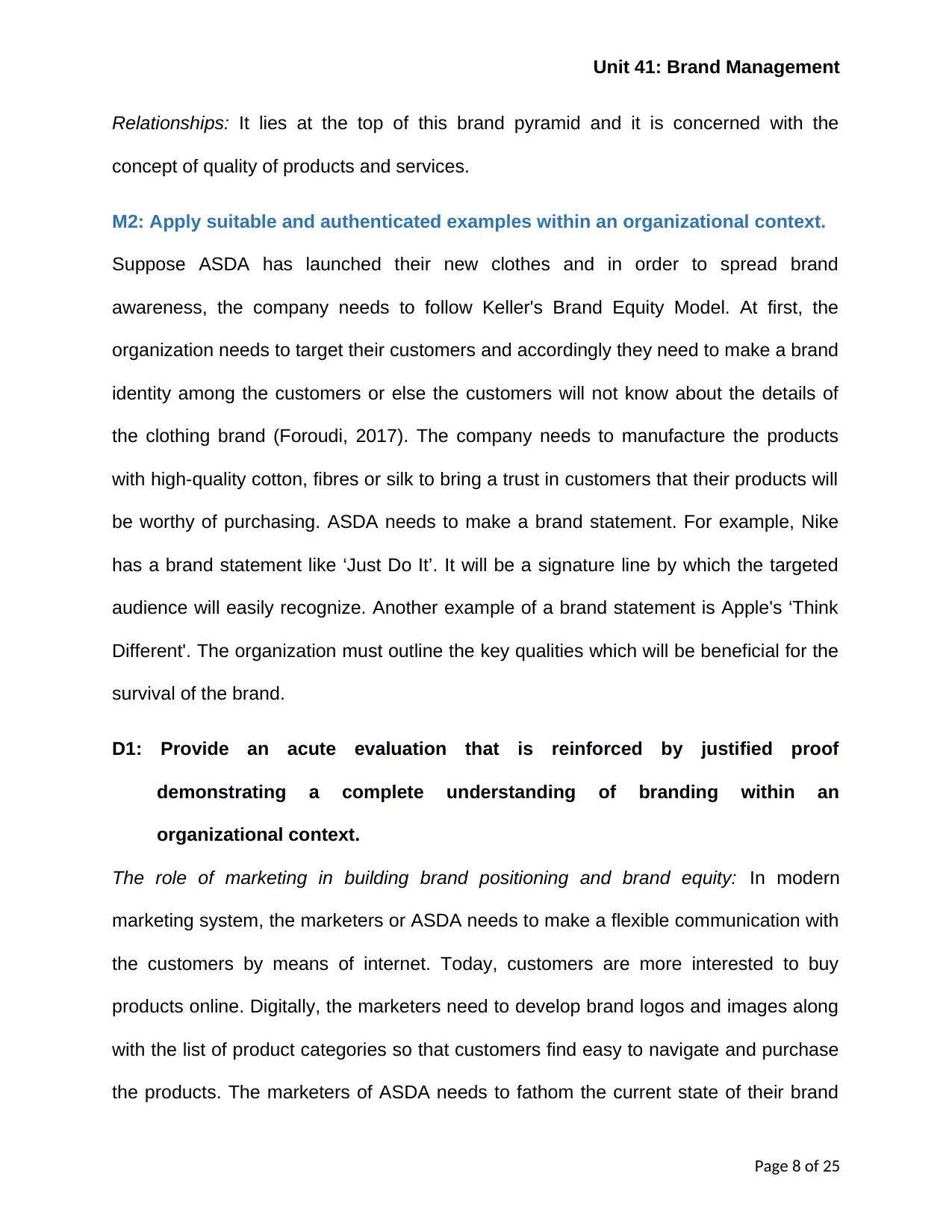
Unit 41: Brand Management
Relationships: It lies at the top of this brand pyramid and it is concerned with the
concept of quality of products and services.
M2: Apply suitable and authenticated examples within an organizational context.
Suppose ASDA has launched their new clothes and in order to spread brand
awareness, the company needs to follow Keller's Brand Equity Model. At first, the
organization needs to target their customers and accordingly they need to make a brand
identity among the customers or else the customers will not know about the details of
the clothing brand (Foroudi, 2017). The company needs to manufacture the products
with high-quality cotton, fibres or silk to bring a trust in customers that their products will
be worthy of purchasing. ASDA needs to make a brand statement. For example, Nike
has a brand statement like ‘Just Do It’. It will be a signature line by which the targeted
audience will easily recognize. Another example of a brand statement is Apple's ‘Think
Different'. The organization must outline the key qualities which will be beneficial for the
survival of the brand.
D1: Provide an acute evaluation that is reinforced by justified proof
demonstrating a complete understanding of branding within an
organizational context.
The role of marketing in building brand positioning and brand equity: In modern
marketing system, the marketers or ASDA needs to make a flexible communication with
the customers by means of internet. Today, customers are more interested to buy
products online. Digitally, the marketers need to develop brand logos and images along
with the list of product categories so that customers find easy to navigate and purchase
the products. The marketers of ASDA needs to fathom the current state of their brand
Page 8 of 25
Relationships: It lies at the top of this brand pyramid and it is concerned with the
concept of quality of products and services.
M2: Apply suitable and authenticated examples within an organizational context.
Suppose ASDA has launched their new clothes and in order to spread brand
awareness, the company needs to follow Keller's Brand Equity Model. At first, the
organization needs to target their customers and accordingly they need to make a brand
identity among the customers or else the customers will not know about the details of
the clothing brand (Foroudi, 2017). The company needs to manufacture the products
with high-quality cotton, fibres or silk to bring a trust in customers that their products will
be worthy of purchasing. ASDA needs to make a brand statement. For example, Nike
has a brand statement like ‘Just Do It’. It will be a signature line by which the targeted
audience will easily recognize. Another example of a brand statement is Apple's ‘Think
Different'. The organization must outline the key qualities which will be beneficial for the
survival of the brand.
D1: Provide an acute evaluation that is reinforced by justified proof
demonstrating a complete understanding of branding within an
organizational context.
The role of marketing in building brand positioning and brand equity: In modern
marketing system, the marketers or ASDA needs to make a flexible communication with
the customers by means of internet. Today, customers are more interested to buy
products online. Digitally, the marketers need to develop brand logos and images along
with the list of product categories so that customers find easy to navigate and purchase
the products. The marketers of ASDA needs to fathom the current state of their brand
Page 8 of 25
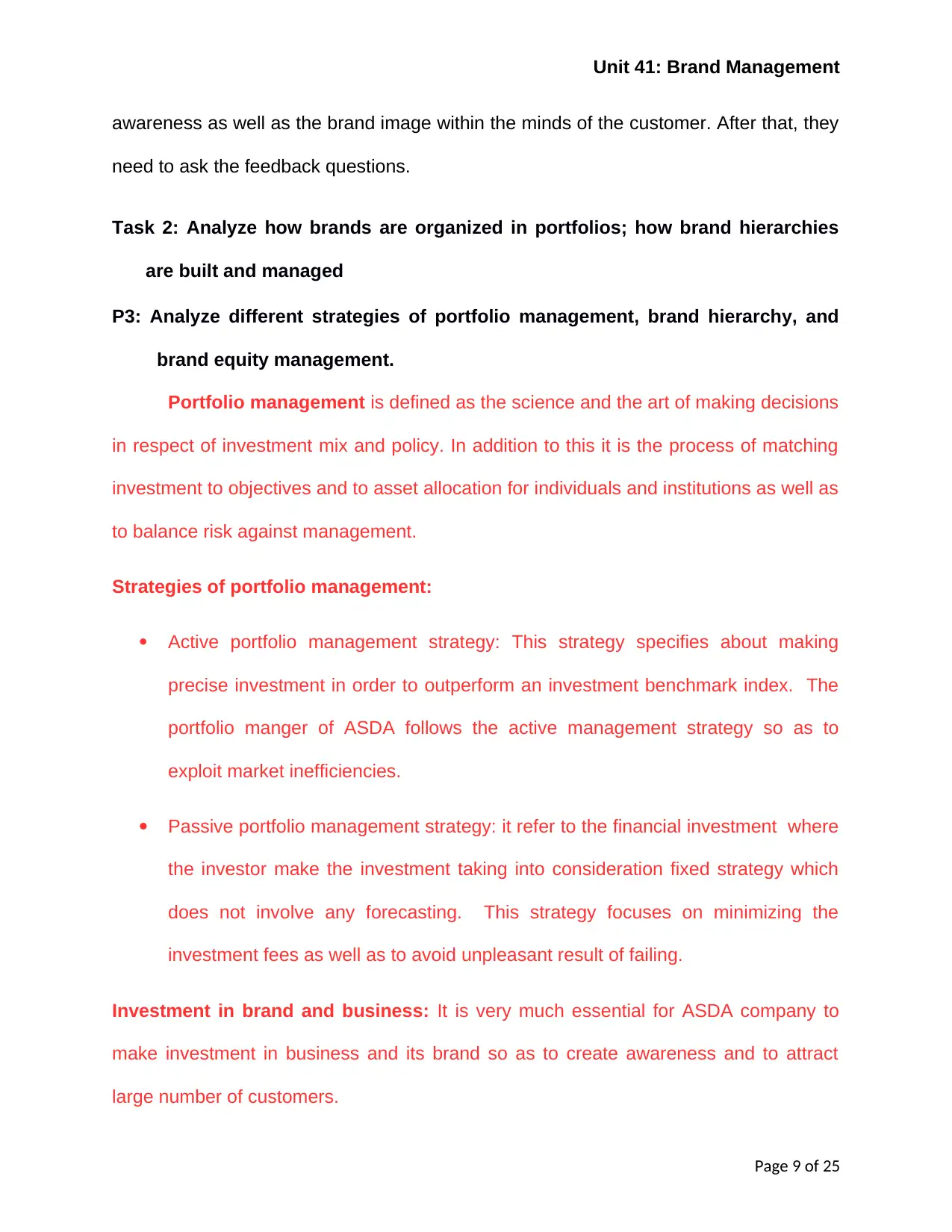
Unit 41: Brand Management
awareness as well as the brand image within the minds of the customer. After that, they
need to ask the feedback questions.
Task 2: Analyze how brands are organized in portfolios; how brand hierarchies
are built and managed
P3: Analyze different strategies of portfolio management, brand hierarchy, and
brand equity management.
Portfolio management is defined as the science and the art of making decisions
in respect of investment mix and policy. In addition to this it is the process of matching
investment to objectives and to asset allocation for individuals and institutions as well as
to balance risk against management.
Strategies of portfolio management:
Active portfolio management strategy: This strategy specifies about making
precise investment in order to outperform an investment benchmark index. The
portfolio manger of ASDA follows the active management strategy so as to
exploit market inefficiencies.
Passive portfolio management strategy: it refer to the financial investment where
the investor make the investment taking into consideration fixed strategy which
does not involve any forecasting. This strategy focuses on minimizing the
investment fees as well as to avoid unpleasant result of failing.
Investment in brand and business: It is very much essential for ASDA company to
make investment in business and its brand so as to create awareness and to attract
large number of customers.
Page 9 of 25
awareness as well as the brand image within the minds of the customer. After that, they
need to ask the feedback questions.
Task 2: Analyze how brands are organized in portfolios; how brand hierarchies
are built and managed
P3: Analyze different strategies of portfolio management, brand hierarchy, and
brand equity management.
Portfolio management is defined as the science and the art of making decisions
in respect of investment mix and policy. In addition to this it is the process of matching
investment to objectives and to asset allocation for individuals and institutions as well as
to balance risk against management.
Strategies of portfolio management:
Active portfolio management strategy: This strategy specifies about making
precise investment in order to outperform an investment benchmark index. The
portfolio manger of ASDA follows the active management strategy so as to
exploit market inefficiencies.
Passive portfolio management strategy: it refer to the financial investment where
the investor make the investment taking into consideration fixed strategy which
does not involve any forecasting. This strategy focuses on minimizing the
investment fees as well as to avoid unpleasant result of failing.
Investment in brand and business: It is very much essential for ASDA company to
make investment in business and its brand so as to create awareness and to attract
large number of customers.
Page 9 of 25
⊘ This is a preview!⊘
Do you want full access?
Subscribe today to unlock all pages.

Trusted by 1+ million students worldwide
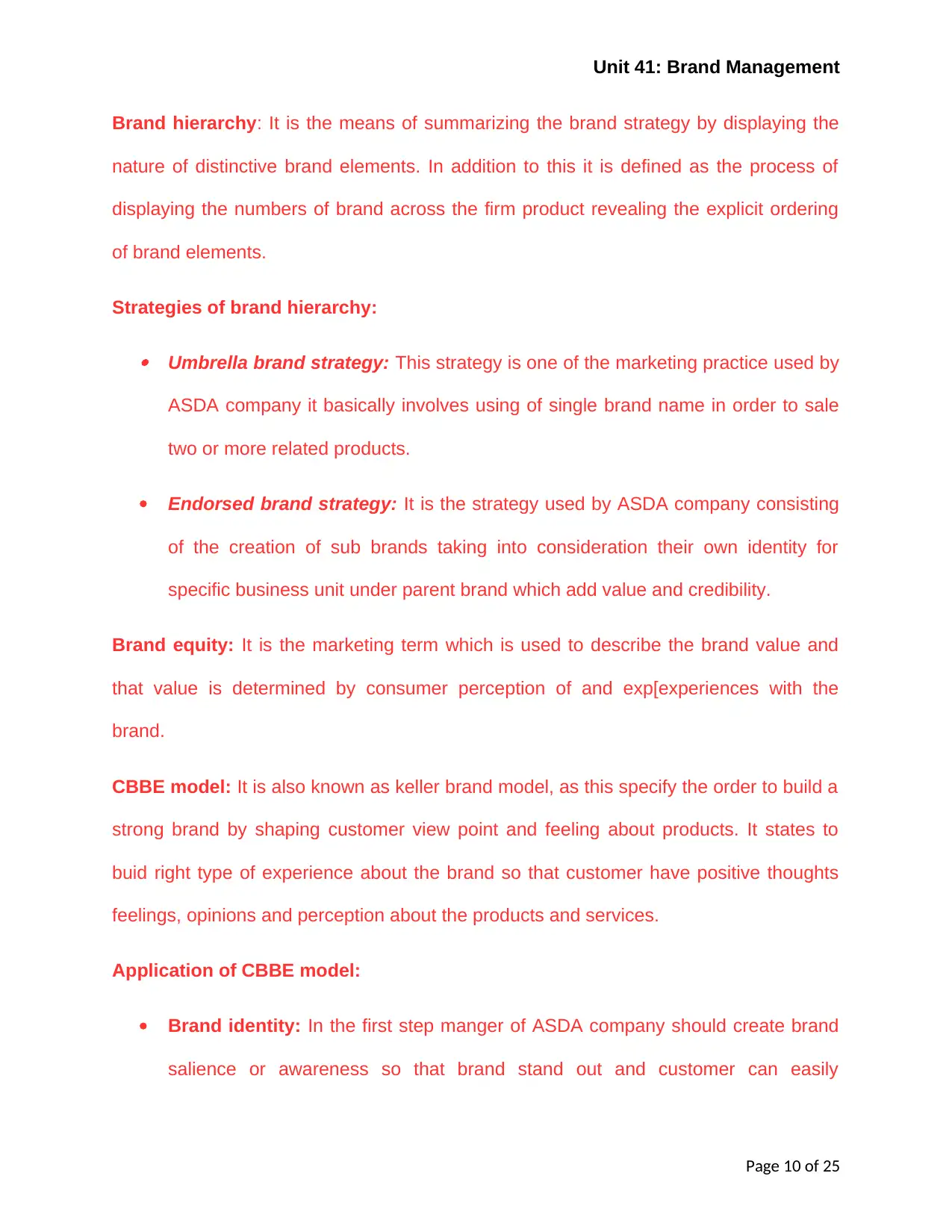
Unit 41: Brand Management
Brand hierarchy: It is the means of summarizing the brand strategy by displaying the
nature of distinctive brand elements. In addition to this it is defined as the process of
displaying the numbers of brand across the firm product revealing the explicit ordering
of brand elements.
Strategies of brand hierarchy:
Umbrella brand strategy: This strategy is one of the marketing practice used by
ASDA company it basically involves using of single brand name in order to sale
two or more related products.
Endorsed brand strategy: It is the strategy used by ASDA company consisting
of the creation of sub brands taking into consideration their own identity for
specific business unit under parent brand which add value and credibility.
Brand equity: It is the marketing term which is used to describe the brand value and
that value is determined by consumer perception of and exp[experiences with the
brand.
CBBE model: It is also known as keller brand model, as this specify the order to build a
strong brand by shaping customer view point and feeling about products. It states to
buid right type of experience about the brand so that customer have positive thoughts
feelings, opinions and perception about the products and services.
Application of CBBE model:
Brand identity: In the first step manger of ASDA company should create brand
salience or awareness so that brand stand out and customer can easily
Page 10 of 25
Brand hierarchy: It is the means of summarizing the brand strategy by displaying the
nature of distinctive brand elements. In addition to this it is defined as the process of
displaying the numbers of brand across the firm product revealing the explicit ordering
of brand elements.
Strategies of brand hierarchy:
Umbrella brand strategy: This strategy is one of the marketing practice used by
ASDA company it basically involves using of single brand name in order to sale
two or more related products.
Endorsed brand strategy: It is the strategy used by ASDA company consisting
of the creation of sub brands taking into consideration their own identity for
specific business unit under parent brand which add value and credibility.
Brand equity: It is the marketing term which is used to describe the brand value and
that value is determined by consumer perception of and exp[experiences with the
brand.
CBBE model: It is also known as keller brand model, as this specify the order to build a
strong brand by shaping customer view point and feeling about products. It states to
buid right type of experience about the brand so that customer have positive thoughts
feelings, opinions and perception about the products and services.
Application of CBBE model:
Brand identity: In the first step manger of ASDA company should create brand
salience or awareness so that brand stand out and customer can easily
Page 10 of 25
Paraphrase This Document
Need a fresh take? Get an instant paraphrase of this document with our AI Paraphraser
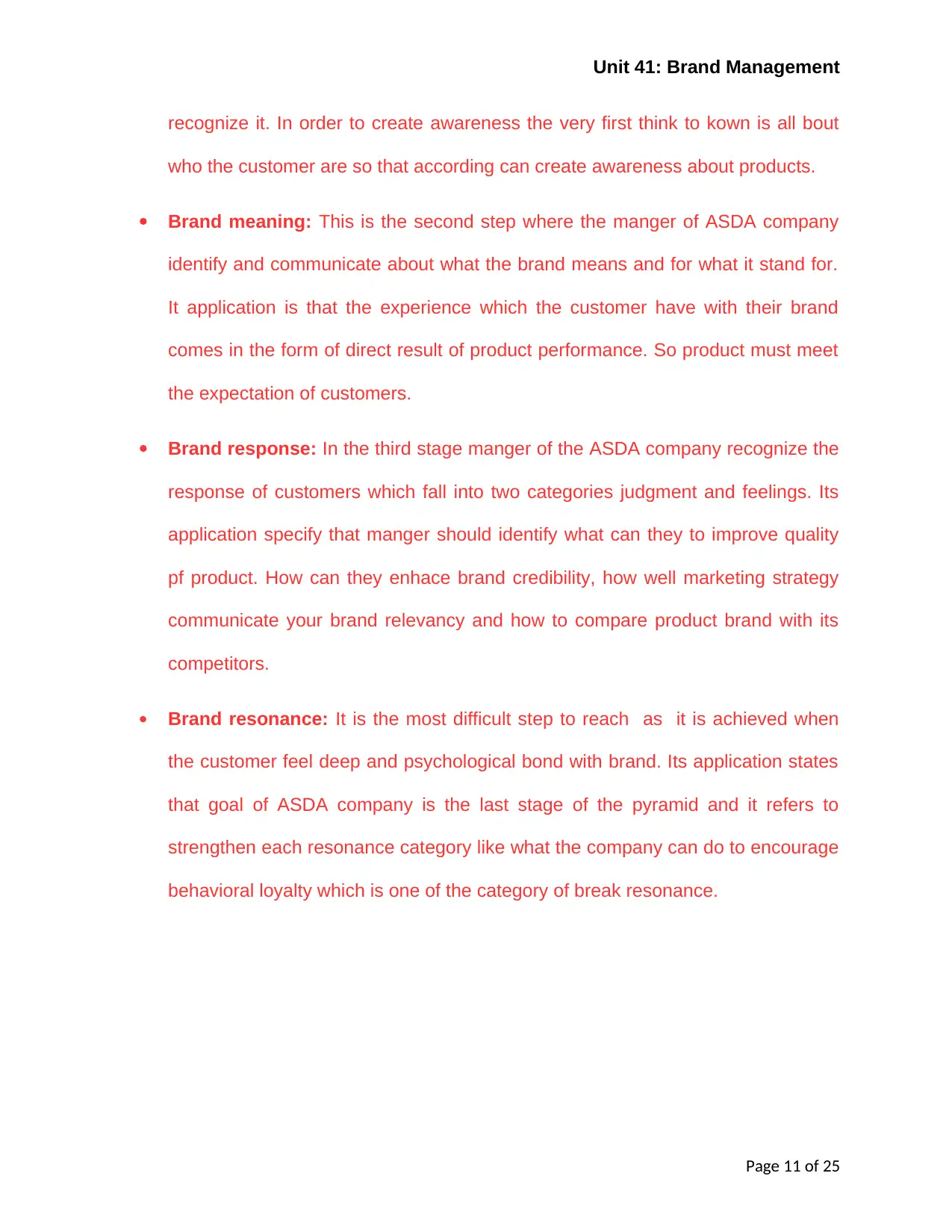
Unit 41: Brand Management
recognize it. In order to create awareness the very first think to kown is all bout
who the customer are so that according can create awareness about products.
Brand meaning: This is the second step where the manger of ASDA company
identify and communicate about what the brand means and for what it stand for.
It application is that the experience which the customer have with their brand
comes in the form of direct result of product performance. So product must meet
the expectation of customers.
Brand response: In the third stage manger of the ASDA company recognize the
response of customers which fall into two categories judgment and feelings. Its
application specify that manger should identify what can they to improve quality
pf product. How can they enhace brand credibility, how well marketing strategy
communicate your brand relevancy and how to compare product brand with its
competitors.
Brand resonance: It is the most difficult step to reach as it is achieved when
the customer feel deep and psychological bond with brand. Its application states
that goal of ASDA company is the last stage of the pyramid and it refers to
strengthen each resonance category like what the company can do to encourage
behavioral loyalty which is one of the category of break resonance.
Page 11 of 25
recognize it. In order to create awareness the very first think to kown is all bout
who the customer are so that according can create awareness about products.
Brand meaning: This is the second step where the manger of ASDA company
identify and communicate about what the brand means and for what it stand for.
It application is that the experience which the customer have with their brand
comes in the form of direct result of product performance. So product must meet
the expectation of customers.
Brand response: In the third stage manger of the ASDA company recognize the
response of customers which fall into two categories judgment and feelings. Its
application specify that manger should identify what can they to improve quality
pf product. How can they enhace brand credibility, how well marketing strategy
communicate your brand relevancy and how to compare product brand with its
competitors.
Brand resonance: It is the most difficult step to reach as it is achieved when
the customer feel deep and psychological bond with brand. Its application states
that goal of ASDA company is the last stage of the pyramid and it refers to
strengthen each resonance category like what the company can do to encourage
behavioral loyalty which is one of the category of break resonance.
Page 11 of 25
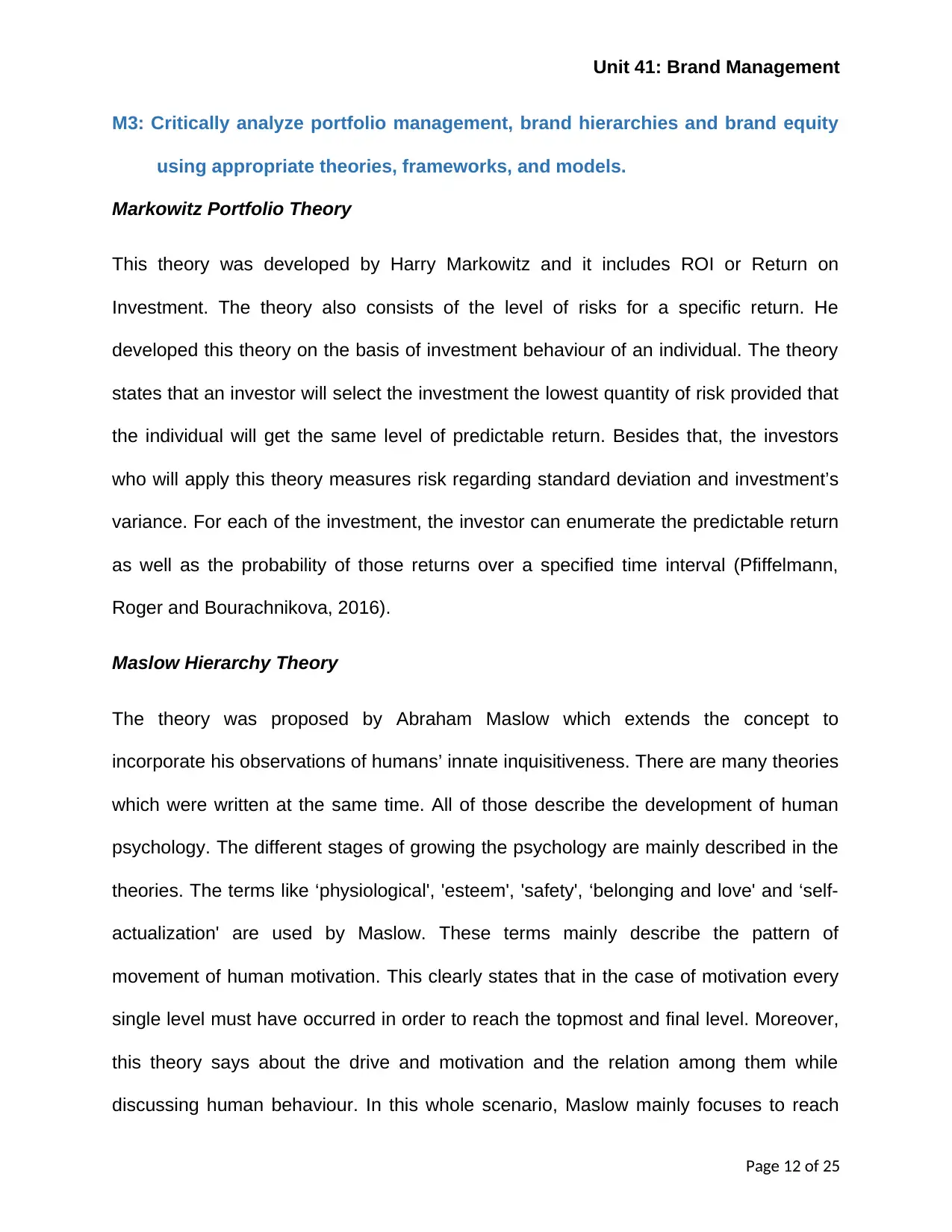
Unit 41: Brand Management
M3: Critically analyze portfolio management, brand hierarchies and brand equity
using appropriate theories, frameworks, and models.
Markowitz Portfolio Theory
This theory was developed by Harry Markowitz and it includes ROI or Return on
Investment. The theory also consists of the level of risks for a specific return. He
developed this theory on the basis of investment behaviour of an individual. The theory
states that an investor will select the investment the lowest quantity of risk provided that
the individual will get the same level of predictable return. Besides that, the investors
who will apply this theory measures risk regarding standard deviation and investment’s
variance. For each of the investment, the investor can enumerate the predictable return
as well as the probability of those returns over a specified time interval (Pfiffelmann,
Roger and Bourachnikova, 2016).
Maslow Hierarchy Theory
The theory was proposed by Abraham Maslow which extends the concept to
incorporate his observations of humans’ innate inquisitiveness. There are many theories
which were written at the same time. All of those describe the development of human
psychology. The different stages of growing the psychology are mainly described in the
theories. The terms like ‘physiological', 'esteem', 'safety', ‘belonging and love' and ‘self-
actualization' are used by Maslow. These terms mainly describe the pattern of
movement of human motivation. This clearly states that in the case of motivation every
single level must have occurred in order to reach the topmost and final level. Moreover,
this theory says about the drive and motivation and the relation among them while
discussing human behaviour. In this whole scenario, Maslow mainly focuses to reach
Page 12 of 25
M3: Critically analyze portfolio management, brand hierarchies and brand equity
using appropriate theories, frameworks, and models.
Markowitz Portfolio Theory
This theory was developed by Harry Markowitz and it includes ROI or Return on
Investment. The theory also consists of the level of risks for a specific return. He
developed this theory on the basis of investment behaviour of an individual. The theory
states that an investor will select the investment the lowest quantity of risk provided that
the individual will get the same level of predictable return. Besides that, the investors
who will apply this theory measures risk regarding standard deviation and investment’s
variance. For each of the investment, the investor can enumerate the predictable return
as well as the probability of those returns over a specified time interval (Pfiffelmann,
Roger and Bourachnikova, 2016).
Maslow Hierarchy Theory
The theory was proposed by Abraham Maslow which extends the concept to
incorporate his observations of humans’ innate inquisitiveness. There are many theories
which were written at the same time. All of those describe the development of human
psychology. The different stages of growing the psychology are mainly described in the
theories. The terms like ‘physiological', 'esteem', 'safety', ‘belonging and love' and ‘self-
actualization' are used by Maslow. These terms mainly describe the pattern of
movement of human motivation. This clearly states that in the case of motivation every
single level must have occurred in order to reach the topmost and final level. Moreover,
this theory says about the drive and motivation and the relation among them while
discussing human behaviour. In this whole scenario, Maslow mainly focuses to reach
Page 12 of 25
⊘ This is a preview!⊘
Do you want full access?
Subscribe today to unlock all pages.

Trusted by 1+ million students worldwide
1 out of 25
Related Documents
Your All-in-One AI-Powered Toolkit for Academic Success.
+13062052269
info@desklib.com
Available 24*7 on WhatsApp / Email
![[object Object]](/_next/static/media/star-bottom.7253800d.svg)
Unlock your academic potential
Copyright © 2020–2025 A2Z Services. All Rights Reserved. Developed and managed by ZUCOL.


